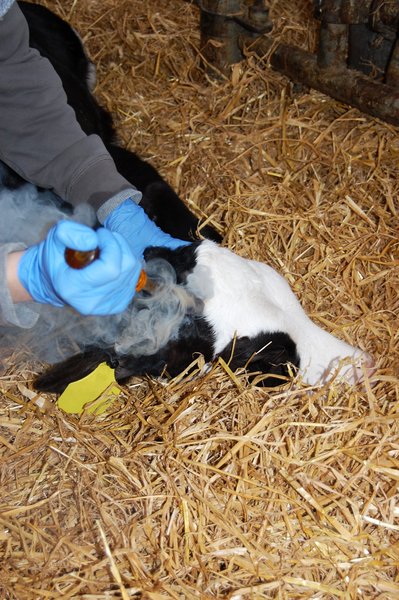New knowledge from Aarhus University of anaesthesia when disbudding calves
Despite preceding local anaesthesia, more than 40% of calves showed behavioural responses at disbudding – especially when using a hot iron with a big tip. This is the conclusion from an experiment conducted at Department of Animal Science, Aarhus University. The experiment is part of a master thesis project at the education “Assessment of animal welfare in the primary production”.


In modern dairy cattle production, it is common practice to disbud calves in order to limit the risk of the animals hurting each other or humans. In Denmark, you are only allowed to disbud calves younger than three months. The only legal method for disbudding in Denmark is to use a hot iron after a veterinarian has applied local anaesthesia prior to the procedure.
“In Denmark, the only drug legal for local anaesthesia when disbudding is procaine. However, most experiments that have documented the benefits of local anaesthesia have used lidocaine. Therefore, Jennie Hed Hansen, who is one of our master students at the education of assessment of welfare in the primary production, decided to examine the efficacy of procaine when it comes to disbudding of calves. The experiment was conducted in a number of Danish dairy herds”, says senior researcher Mette S. Herskin who has led the study together with professor Peter T. Thomsen.
Calves from eight different dairy herds
In total, the experiment included 167 calves from eight different dairy herds. The majority of the calves were Holstein (62%) and Jersey (26%). The mean age of the calves at the time of disbudding was 61 days.
What the researchers looked deeper into in the study was:
- The calves’ behavioural responses when the hot iron was applied.
- Whether there was an association between the calves’ behavioural responses and the time from application of anaesthesia until disbudding.
- Whether there was an association between the calves’ behavioural responses and the size of the hot iron (=the contact surface to the calf’s skin).
Prior to disbudding, the herd veterinarian gave the calves a sedative (xylazine) and applied procaine as a local anaesthetic. After that, the veterinarian or the farmer disbudded the calves according to the herd’s standard procedure.
Behavioural observations and the type of hot iron
The calves’ behavioural responses were observed focusing on three types of behavioural response:
- The calf gets up on all four legs.
- The calf kicks with at least one leg.
- The calf lifts its head.
Two types of hot irons were used in the experiment: a small hot iron with a copper tip of Ø23 mm and a bigger hot iron with a copper tip of Ø33 mm.
More behavioural responses when using the big hot iron
The results showed that 42% of the calves reacted with at least one of the behavioural responses during disbudding. Only every third of the calves that were disbudded with the small hot iron showed at least one of the behavioural responses, whereas more than half of the calves that were disbudded with the big hot iron showed at least one of the three behavioural responses.
The results suggest that some calves were not sufficiently pain relieved during the procedure. Furthermore, it also seems that the size of the hot iron is of importance as more calves showed behavioural responses when using the big hot iron compared to using the small hot iron.
“Our results suggest that it may be an advantage to the calves’ welfare if you practice early disbudding and therefore can use a small hot iron. However, further studies are needed to document this”, says Peter T. Thomsen.
Behind the research
FundingAarhus University |
PartnersNo external partners |
More informationLink to the intire scientific article: Dairy calves show behavioural responses to hot iron disbudding after local anaesthesia with procaine |
ContactSenior researcher Mette S. Herskin, Department of Animal Science, Aarhus University. E-mail: MetteS.Herskin@anis.au.dk
Professor Peter T. Thomsen, Department of Animal Science, Aarhus University. E-mail: ptt@anis.au.dk |
